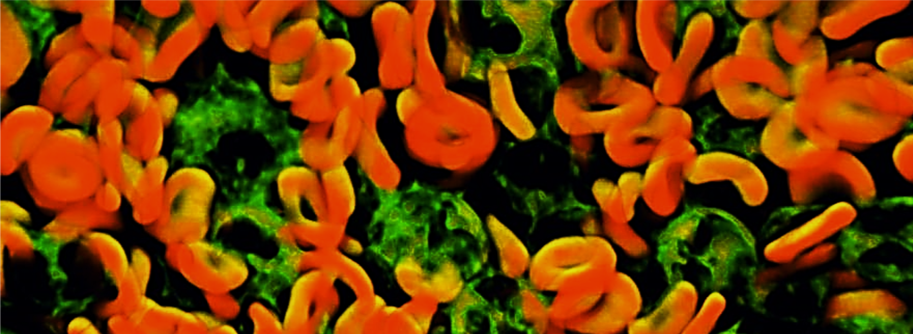Home - About - Core Facilities - Cell Imaging

The LDI Cell Imaging Facility is a fee-for-service facility located on the 4th and 5th floors of the E Pavilion of the Jewish General Hospital (JGH) and on the 3rd floor of the Lady Davis Institute for Medical Research (LDI). Our mission is to provide expertise in confocal, live cell, and fluorescent microscopy to the researchers of the LDI as well as external academic and industry researchers in terms of experimental design, instrumentation, training, technical assistance, and scientific guidance.
The LDI Cell Imaging Facility provides researchers with instrumentation, scientific expertise, and guidance. Our facility consists of:
Three confocal microscopes:
Two confocal systems for intravital imaging:
Several widefield microscopes, including a Leica DM LB2 widefield upright microscope.
One NIS and one Volocity analysis station are also available.
The Zeiss LSM800 is an inverted laser-scanning confocal microscope equipped with Airyscan, allowing for super-resolution imaging.
Images:
BSL I samples
Four lasers at 405nm, 488nm, 561nm, and 640nm are present, with a variable secondary dichroic allowing for imaging of any emission wavelength between 410-700nm.
Airyscan module for super-resolution imaging.
Technical assistance by Cell Imaging Facility staff
Trained users
LDI Core Booking Calendar
For training, contact the LDI Cell Imaging Facility
The Quorum Wave FX SD confocal microscope is an inverted confocal microscope using spinning disk technology, which significantly reduces photobleaching and phototoxicity.
Images:
BSL I samples
4 laser (405nm, 488nm, 561nm, 640nm) for fluorescence imaging
Environmental control for live cell imaging via stage-top incubator (temperature, CO2, humidity control)
Technical assistance by Cell Imaging Facility Staff
Trained users
LDI Core Booking Calendar
For training, contact the LDI Cell Imaging Facility
Imaging platform that includes a spinning disc confocal microscope and a point-scanning confocal microscope and that is primarily designed for intravital microscopy.
Images:
Live tissues, such as lung, breast, flank, skin and the brain
Cleared organs
Tissue sections
BSL I and BSL II samples
The spinning disc confocal unit is equipped with 4 laser lines: 405nm, 488nm, 561nm, 640nm for 4-colour fluorescence imaging in the range of 350nm-750nm.
The point scanner is equipped with 5 laser lines (405nm, 488nm, 561nm, 640nm and 730nm) for 5-colour fluorescence imaging (350nm-750nm).
Technical assistance by Cell Imaging Facility staff
Trained users
Contact Cell Imaging Facility staff
An inverted confocal microscope is equipped with the CrestX-Light V3 Spinning Disc.
Images:
Live tissues, such as the liver, spleen and the intestine
In vitro cell samples
BSL I samples
BSL II samples, coming soon!
It has 7 laser lines: (408nm), (445nm), (473nm), (518nm), (545nm), (635nm) and (750nm) for 7 color imaging.
Dual camera for ultrahigh acquisition speed
Technical assistance by Cell Imaging Facility staff
Trained users
Contact Cell Imaging Facility staff
An inverted point-scanning confocal microscope equipped with an NSPARC module for super resolution imaging and a UV irradiation laser for DNA damage experiments.
Images:
Tissue sections and fixed cells
In vitro cell samples
Embryos and cleared organs
BSL I samples
BSL II samples, coming soon!
4 laser lines (405nm, 488nm, 561nm, 640nm) for 4-colour fluorescence imaging. The detectors are adjustable and will permit spectral imaging
NSPARC module for super-resolution imaging
UV 355nm laser for DNA damage experiments
Technical assistance by Cell Imaging Facility staff
Trained users
LDI Core Booking Calendar
For training, contact the LDI Cell Imaging Facility
The Leica DM LB2 is a widefield microscope with an upright stand. Light sources of 100W halogen lamps and 100W mercury lamps are able to perform both bright-filed and fluorescence imaging on a slide. This system is equipped with a monochrome and colour camera and is ideal for basic fluorescence imaging and immunohistochemistry studies.
Pavilion E, Room-5412
N Plan / 10X, Air/ 0.25 NA
HC PL Fluotar / 20X, Air/ 0.50 NA
HCX PL Fluotar / 40X, Air/ 0.75 NA/ Ph2
N Plan / 100X, Oil/ 1.25 NA
Leica DFC 480 (Color Digital Camera)
Leica DFC 350 Fx (Monochrome Digital Camera)
The LDI core facilities uses the core scheduler accessible at https://corescheduler.ladydavis.ca/
A highly qualified LDI Cell Imaging Facility staff member can acquire and analyze your cell imaging experiments. Please contact us to make an appointment. We will assess the feasibility of your experiment and schedule your run.
| Cell Imaging Facility Services | Minimum Time Charged (min) | Internal LDI Rates ($/h/user) | External Academic Rates ($/h/user) | External Commercial Rates ($/h/user) |
| Confocal Imaging | 10 | 25.00 | 100.00 | — |
| Confocal Live Cell | 10 | 15.00* | 20.00* | — |
| Confocal with Assistance | 60 | 60.00 | 100.00 | 200.00 |
| Confocal Training | 60 | 60.00 | 100.00 | — |
| Volocity Software 3D/4D Image Analysis | 10 | 10.00 | 20.00 | — |
| Leica DM LB2 Widefield Upright Microscope | — | Free | — | — |
| Zeiss Axiovert 40 CFL Widefield Inverted Microscope | — | Free | — | — |
| Data Analysis/Consultation** | 30 | 35.00 | — | — |
* Live cell imaging rates applies after 4-hour initial setup at Imaging, Self operator or with assistance rates.
Lady Davis Institute for Medical Research, Rm E-415
Jewish General Hospital
3999 Côte Ste-Catherine Road
Montreal, Qc
H3T 1E2
You have the power to make a difference! Your gift will support vital research at the Lady Davis Institute for Medical Research (LDI) that will translate into disease prevention, improved diagnoses, earlier detection, new and enhanced therapies, a better quality of life, wellness and hope for all of us.
Faire la différence, vous avez ce don! Votre contribution soutiendra la recherche essentielle menée à l’Institut Lady Davis qui permettra la prévention des maladies, des diagnostics plus précis, des dépistages plus rapides, des traitements innovants et plus performants, une meilleure qualité de vie, le bien-être et l’espoir pour nous tous.
Copyright © 2024 | Lady Davis Institute for Medical Research/Jewish General Hospital
Conception et développement : Yankee Media